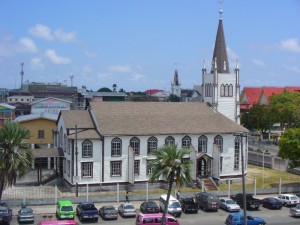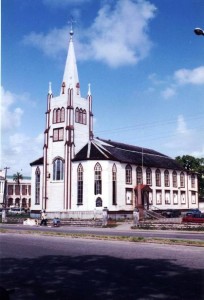From Dutch Reformed to Scots Presbyterian Church


Nearly one hundred and ninety-five years ago, on September 27, 1818, a new church was opened in Georgetown, finally satisfying the spiritual needs of the growing number of Scottish inhabitants and signalling the beginning of the Scots Presbyterian Church community in the country.
This new church was St Andrew’s Kirk, currently the oldest religious building (and probably the oldest building) still in use in Georgetown. The commencement of the construction of the building itself was much earlier, however, the first foundation sill being laid with much pomp and ceremony on August 12, 1811, but for a Dutch Reformed Church (Kerk).
With the restoration of Demerara to the Dutch in 1784 and the re-naming of the new town to Stabroek, the Dutch Reformed Kerk established itself. Though the Dutch finally lost the colony in 1803, the Dutch Reformed Kerk acquired the present site in 1810 – a gift from the government – for the building of a church. Funding for the proposed building was achieved mainly through public subscription and the building – framework only – was opened for service in 1812.
Unfortunately for the Dutch, they experienced financial difficulties, and the unfinished building was sold under the Marshall’s hammer on May 4, 1813. The structure was bought by two members of the Consistory, the Hon F P van Berckel and Mr V A Heyliger, the former purchasing all the shares save one and the latter the remaining share. Nothing further was done to complete the building, however, the timber framework left exposed to the weather for over two years.

About the middle of 1815, a suggestion was made that the Dutch and Scottish populations come together and finish the building, but it was not then taken up. With some resolve from the Scotsmen, there was eventually an agreement with van Berckel and Heyliger about the transfer of the shares and in June 1816 the transport was passed.
Following its opening in September 1818, the Dutch remained co-users of the building for many years afterwards, but their numbers began waning, some joining the Scots congregation. Eventually, in April 1871, the Scottish Minister, Rev Thomas Slater, reported that the Sacramental Service of the Dutch Reformed Kerk was handed over to him, making St Andrew’s Presbyterian sole owner of the building.
The architecture of St Andrew’s was achieved by numerous changes over the years. The original building was at about 15 percent smaller than present, and it was planned along the lines of the Romanesque Revival architectural style (called Norman in England) rather than the Gothic Revival Architecture we now see.
From its early days, St Andrew’s played an important part in the social and cultural life of the community. As early as 1819, for example, slaves were admitted as members, and during the period 1819-1821 fifty-five slaves were admitted to the congregation.
The Church held the first sacred concert in the Colony, when on December 11, 1822, music from the choir accompanied by a new organ and the 21st Fusiliers band, filled the church hall at a well-attended public concert.
The building also saw “military service” when in late 1823, during a major slave uprising, it was requisitioned as the barracks for the Provisional Battalion of the Demerara Militia because of the church’s close proximity to the Guard House opposite. This “occupation” lasted for about five months. (LJ Hernandez, Senior Lecturer, Department of Architecture, University of Guyana)



